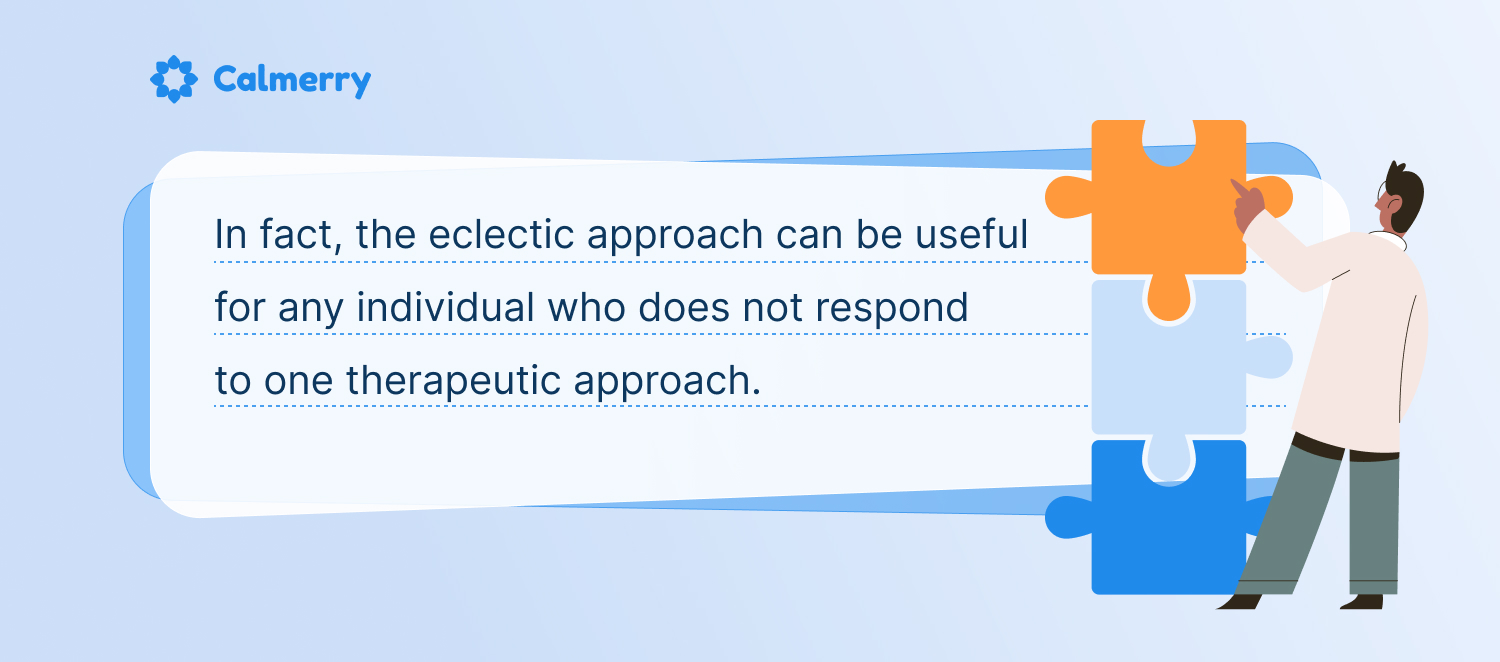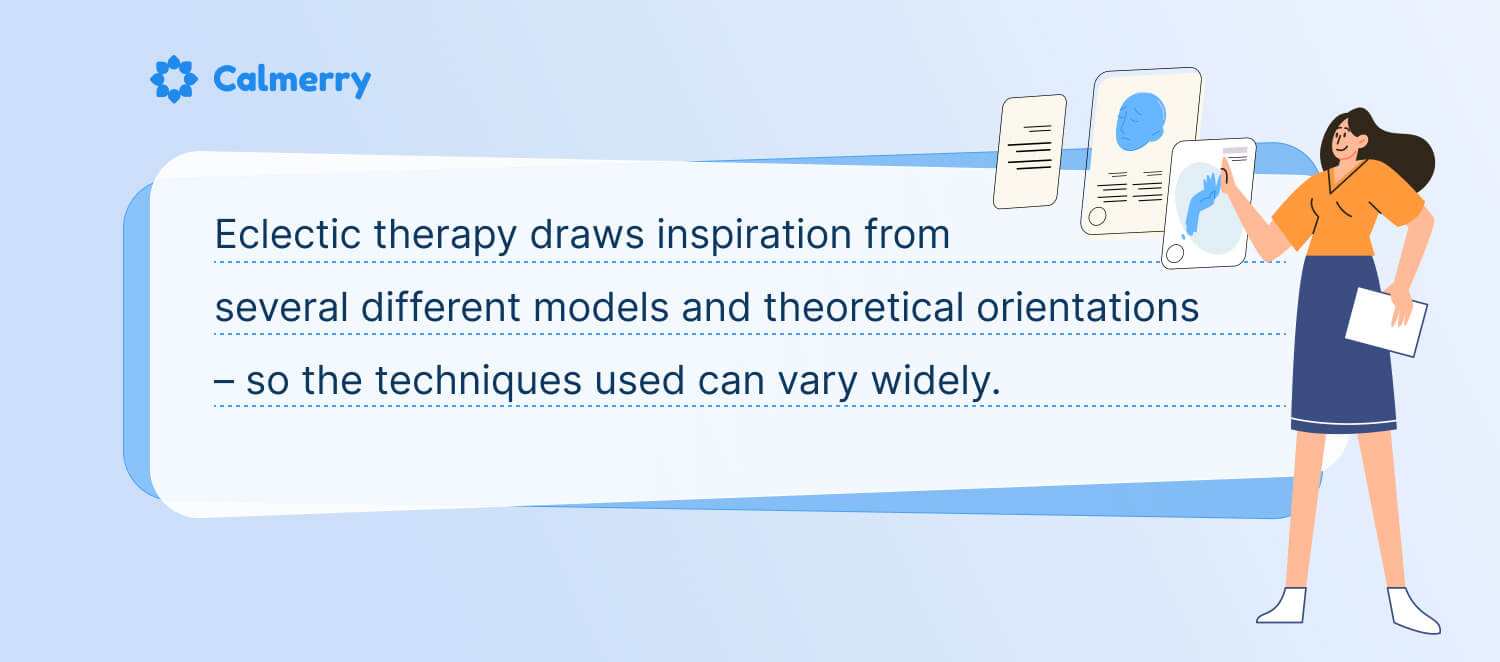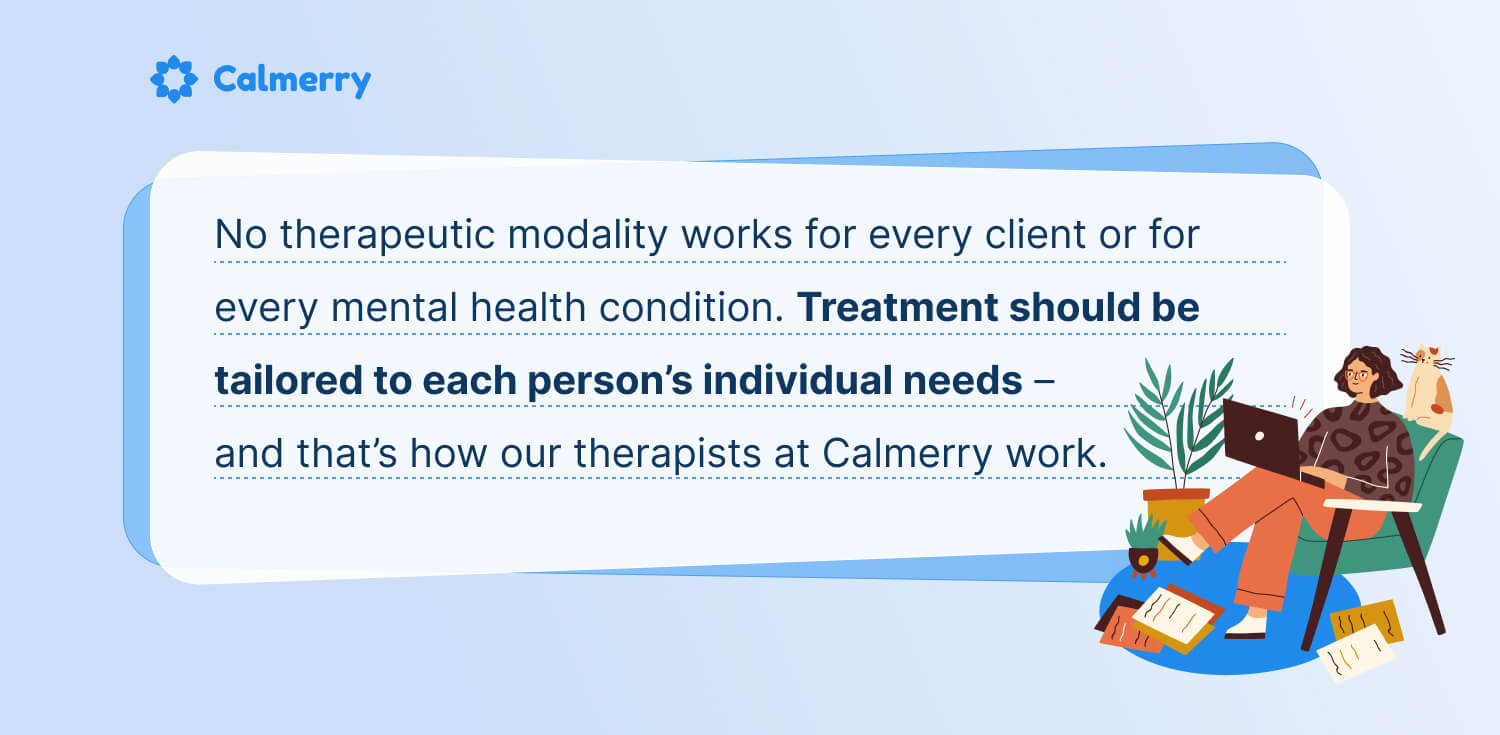Eclectic Therapy: Types, How It Works, and Who It Can Help

In this article
When a person seeks treatment from a mental health professional, the therapist or psychologist providing services typically uses a specific treatment modality. These various modalities are based on theories and research on factors contributing to psychological problems.
For example, some theories assert that psychological dysfunction arises when people have distorted thinking patterns, whereas others claim that problems are a manifestation of unresolved issues from childhood.
Different therapeutic approaches have been born out of these various theories of human psychology.
While some therapists strictly follow one particular modality, others use a more eclectic approach. When a therapist uses multiple approaches from a variety of different theoretical modalities, they are said to be practicing eclectic therapy, which can be useful for some patients.
What is eclectic therapy?
The eclectic approach to therapy simply involves using strategies and interventions from multiple therapeutic modalities.
There are different schools of thought and theoretical models that contribute to the practice of psychotherapy.
Some therapists subscribe solely to one school of thought and carry out all of their services using methods from this area. On the other hand, the eclectic psychotherapist will use bits and pieces of various theoretical models in their clinical work.
For instance, they may teach mindfulness practices derived from mindfulness-based stress reduction (MBSR) while also guiding patients toward correcting automatic negative thoughts, in line with cognitive behavioral therapy (CBT).
When a therapist uses the eclectic approach, they do not limit themselves to the strategies and interventions used in one specific model. Instead, they combine effective interventions from various models.

What can eclectic therapy treat?
There are multiple different uses of the eclectic approach. This therapeutic modality has been found to be effective for treating anxiety disorders, especially in children.
Eclectic therapy techniques have also been found to be beneficial for treating post-traumatic stress disorder (PTSD).
While eclectic therapy has been most widely studied for treating anxiety and PTSD, there can be other uses of this modality.
In fact, the eclectic approach can be useful for any patient who does not respond to one therapeutic approach. For instance, a patient who has depression symptoms that do not improve with CBT may benefit from an eclectic approach that incorporates strategies from other therapeutic modalities.
Types of eclectic therapy
The term “eclectic therapy” is an umbrella term that refers to using multiple different models in therapy practice. There are several different forms of eclectic therapy, which are described in more detail below.
Brief eclectic therapy
Brief eclectic therapy was originally developed for treating PTSD. This form of eclectic therapy can be completed in 16 sessions. It uses techniques from both psychodynamic and cognitive behavioral therapy to help patients achieve relief from their symptoms.
Cognitive behavioral aspects of brief eclectic therapy guide patients toward changing and helping them to cope with negative thoughts and distressing feelings related to their trauma.
Additionally, the psychodynamic aspects of this approach emphasize feelings of shame and guilt, as well as the relationship between patient and therapist.
Cognitive-interpersonal therapy
As its name suggests, cognitive-interpersonal therapy combines approaches from both the cognitive model and the interpersonal therapy approach.
This approach has been applied to patients with severe mental health problems, including psychosis.
Cognitive-interpersonal therapy uses CBT principles to explore a patient’s thoughts and interpretations of their experiences. It also incorporates interpersonal therapy techniques to identify supportive individuals in a patient’s social network and those who may contribute to stress.
Multimodal therapy
Like eclectic therapy, multimodal therapy is an umbrella term that refers to the use of multiple different methods for treating a psychological condition.
Multimodal therapy methods may combine pharmacotherapy (medications used to treat mental health conditions) and psychosocial interventions (counseling and therapy).
The term “multimodal therapy” can also be used to describe the use of a combination of therapeutic techniques, such as dialectical behavioral therapy in combination with family systems therapy.

Transtheoretical therapy
The transtheoretical therapy model is an eclectic approach that incorporates various methods of change from different therapy models while also considering the different stages of change.
For instance, a patient in the pre-contemplation stage (not thinking about change) would be treated differently from a patient in the preparation stage (getting ready to make changes).
The transtheoretical model uses strategies like consciousness-raising, which is from Freud’s psychodynamic approach, and contingency management approaches, which come from behavioral psychology.
It also focuses on the importance of the helping relationship, drawing on theories from Carl Rogers’ humanistic approach to therapy.
Three-stage model
The three-stage model, or the helping skills model, is also among the eclectic therapy approaches.
- In the first stage, called exploration, a patient examines their thoughts and feelings.
- And in the second stage, called the insight stage, the therapist helps a patient to understand the underlying reasons behind their thoughts and feelings.
- Finally, in stage three, the activation stage, the patient makes changes.
Eclectic therapy techniques
There are multiple potential eclectic therapy techniques, which will vary depending on the specific strategies a clinician is using. Eclectic therapy draws inspiration from several different models and theoretical orientations. So the techniques used can vary widely.
Some common techniques used in the eclectic approach include:
- Exploring unresolved issues from childhood
- Challenging negative or distorted thinking patterns
- Teaching coping skills
- Increasing motivation for change
- Identifying sources of social support
- Building a strong relationship between therapist and patient.
The eclectic psychotherapist will make use of a combination of these different techniques.
What are the advantages and disadvantages of the eclectic approach?
As with any therapeutic style, the eclectic approach has advantages and disadvantages.
Advantages:
One of the advantages of the eclectic approach is that it is so versatile. Since eclectic therapy can use various therapeutic methods, it can be adapted for many situations.
In addition, eclectic therapy can be beneficial for those who do not respond to one specific therapy style.
For example, a patient who experiences depression may not achieve full recovery with cognitive behavioral therapy. Perhaps they benefit some from correcting distorted thinking patterns. But they may also have some unresolved childhood trauma to address. In this case, adding aspects of psychodynamic therapy can be helpful.
Disadvantages:
While the eclectic approach can be beneficial, it is not without drawbacks.
This approach can be complex because it requires a therapist to be trained in multiple modalities or schools of thought.
Additionally, because the eclectic approach uses strategies from a variety of different counseling theories, it can be difficult to determine which specific approach led to changes for the patient.
How effective is eclectic therapy?
Whether eclectic therapy is effective depends on the specific concern that has brought a patient to treatment and the approaches a therapist uses in their work.
Since eclectic psychotherapy is so broad, it is difficult to provide a definitive answer to how effective this approach is on the whole.
Some research has found that eclectic therapy is more beneficial for treating anxiety in children, compared to CBT (which is considered a gold standard method for treating anxiety and depression.)
Furthermore, brief eclectic therapy has been determined to be an evidence-based treatment for PTSD, meaning that significant evidence confirms its effectiveness.
Studies do show that eclectic therapy is beneficial, but that doesn’t mean that it has a 100% success rate. No therapeutic modality works for every patient or for every mental health condition. Treatment should be tailored to each person’s individual needs – and that’s how our therapists at Calmerry work.

What to expect in the first therapy session
If you choose to work with an eclectic therapist, you can expect them to conduct a full assessment during your first session. They will gather information about the problem that has brought you to therapy. This could involve collecting information about your:
- Family
- History of mental and emotional health problems
- Current relationships
- And how the problem that brought you to therapy is affecting your life
During the initial session, your therapist should also explain the therapy process to you so that you know what to expect. They will likely tell you how many sessions you can expect to complete during the therapeutic process and how often you will meet.
They will discuss the approaches they typically use in therapy and work with you to develop goals and objectives for your time together in therapy.
What to look for in an eclectic therapist
An eclectic psychotherapist should demonstrate certain qualities that indicate they are skilled in this approach:
- Your therapist should be able to explain the specific methods they use in their eclectic approach to treatment. For example, if they use techniques from both acceptance and commitment therapy and interpersonal therapy, they should be able to explain these methods to you.
- An eclectic therapist should also have training or expertise in this modality. At the minimum, most therapists have a master’s degree in counseling, social work, or marriage and family therapy.
- An eclectic therapist should also have training in the different modalities they are using in sessions. This could involve an internship during which they worked under the supervision of another eclectic therapist, or they may have professional certification in several different treatment modalities.
- Finally, the eclectic psychotherapist should be skilled in building relationships with patients. They should treat you with dignity and respect and provide a non-judgmental space during your therapy sessions. You should feel comfortable opening up to them and sharing during sessions.
In fact, these are qualities you should seek in any therapist.
Eclectic therapy can be done online
At Calmerry, we offer online therapy and have therapists trained and experienced in the eclectic approach.
If you’re seeking therapy services, and this approach seems like it may be a good fit for you, visit our webpage today to learn more or to get started with online psychotherapy.
online therapy
live video session




